Great-Grandparents of George Alfred Johnson
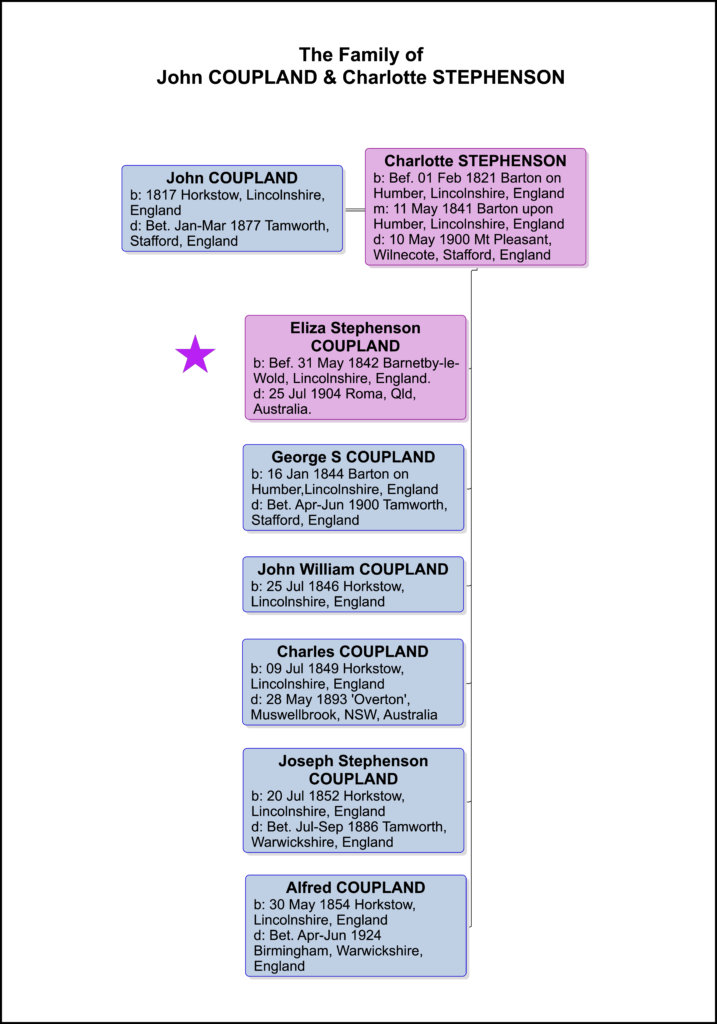
John STEPHENSON
Very little is known of the childhood of John Stephenson. I do not have his parents or even his birth records of any kind. The only information I have been able to glean from the 1851 census was that he was born about 1789-1790 in Lindrick, Yorkshire. There is information about two places called Lindrick in Yorkshire.
The first, mentioned in historical information about Ripon, is from the year 1868 from the UK & Ireland Genealogy website. It lists Lindrick as a township in the parish of Ripon, West Riding county York, and 3 miles west of Ripon. It is a small township consisting of two large farms, and bounding Studley Park on the North and West. Ripon is 35 kilometres north-west of York.
The other mention of Lindrick is that it was an ancient district of England. The majority of the district appears to have lain in what is now South Yorkshire, but the village Carlton-in-Lindrick is in Nottinghamshire. Lindrick seems to have reached as far as Lindrick Dale, Laughton Lindrick Wood, which lay next to Roche Abbey, and the Lindrick area of Tickhill. Tickhill is about 20 kilometres from the west Lincolnshire border.
I looked at baptisms for John Stephenson being born with in a two year period of 1789 and there were 26 results but none near where the two Lindrick towns were. So, perhaps we will never know who his parents were.
Mary GAUTBY
While little is known of John Stephenson’s ancestry, more is known about Mary Gautby. Mary was the youngest daughter of four children of Thomas Gautby and Elizabeth Gaskin. She was baptised on 19th November, 18011 at St Mary’s Church of England at Barton-Upon-Humber or Barton. Her parents are buried in the grounds of St Peter’s Church of England at Barton.
Barton-Upon-Humber
Pigott’s Directory of 1828-1829 describes Barton-upon-Humber and I have put it into a simple form.
“Barton upon Humber was a large market town situated 268 kilometres north of London on the northern extremity of the Lincolnshire wolds and on the southern bank of the river Humber. Barton was a thriving town with good traffic in corn and flour. It had several factories of starch, Paris white (plaster), sacks, ropes, cables, bricks, tiles and potters-ware. There were also several large tanneries.
Barton benefited from the great northern road passing through it to the Humber river then on to Hull in Yorkshire, with packet-boats, for passengers and carriages, crossing the river daily. It was the main legal centre for the area with courts of recovery of debts, petty sessions and magistrates being held monthly, as well as being the polling station at the election of members to represent the division of Lindsey.
There were 2 Churches of England – St. Mary’s and St. Peter’s, the Roman Catholics, Wesleyan and primitive Methodists, and the independents had places of worship. There was a free school, for 20 poor boys, founded in 1722; and Sunday and infants’ schools.
The weekly market day was Monday and a market was held once a fortnight for fat and lean cattle; the annual fair was on Trinity-Thursday and the following day, for horses, oxen, sheep and peddlers’ wares.”
St Mary’s and St. Peter’s
St. Mary’s and St. Peter’s Church of England, Barton.
There were two Churches of England (Anglican) in Barton – St. Mary’s and St. Peter’s – both within several hundred metres of each other. This may seem strange but I’ll explain why.
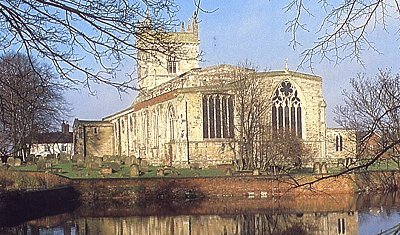
“St. Mary’s (previously known as Chapel of All Saints) was probably built of timber during the seventh century. It has undergone many changes throughout the centuries. St. Mary’s was always a church for the people.
“The earliest building on the present site dates to the 11th century, of which only the lower part of the tower and the north aisle arcade survive. The majority of the building is in the Early English Style with windows dating from the 14th and 15th centuries and window glass assembled in the 17th century. The porch was restored in 1938.”2
St. Peter’s, when first built during the 10th century, was in effect the Lord of the Manor’s private chapel. It was a building of prestige, where the Lord of the Manor could worship with his family and other noble people who would be there at his invitation. It had a small sanctuary, a small private baptistry and a very limited accommodation in the tower nave.
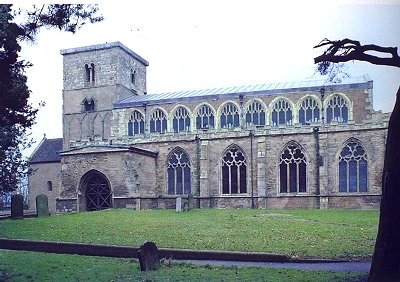
In 1115, St. Peter’s became a Monastic church ruled and governed by the successive Abbots until the dissolution of the Abbey in 1538 (during the rule of King Henry VIII). The people’s reaction to this granting away of the Church was to continue to maintain for themselves a Church of their own, St. Mary’s, providing their own Chaplains and priests totally independent of the Monastery.
By the 18th and 19th centuries, the Churches were both being used by the people of Barton until St. Peter’s was closed in 1970. It is one of the most architecturally important churches in the north of England and was excavated between 1978 and 1985, with some graves and artefacts dating back 1000 years. St Mary’s became the worshipping Church of England for Barton after this closure.
Marriage
John and Mary were married in St Peter’s in Barton on the 10th February, 1818. Mary, being a young 17 year old, and John about 10 or so years older. Mary’s older brother George Gautby was one of the witnesses.
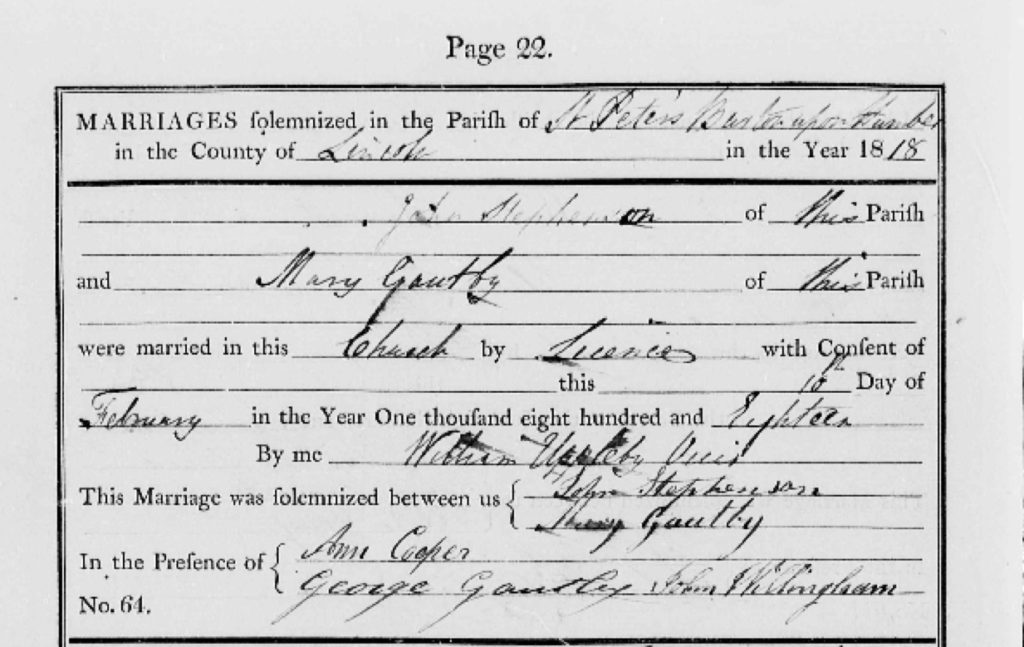
John and Mary settled well in Barton raising a family of, at least ten children, several dying in infancy. John also became a successful businessman. It is noted in the 1828-29 and the 1841 Pigot’s Directory that John was a ‘Nursery and Seedsman’. You had to own a business to be included in the Directory. Their address is listed as Barton Field in both Directories. However their address in the 1841 census is listed as South Field. When looking at other people in South Field, we had several agricultural labourers and a couple of patten-makers. Patten-Makers were shoemakers who mostly made clogs, which were used widely in the fields.
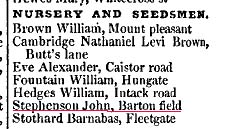
By 1851, the family had moved to Tofts Road with John still in the nursery business. He even had three of his children, Mary, Sarah and Eliza working for him.
John continued rising up the ladder by taking on the business of coal merchant as well as nurseryman by 1861. A coal merchant usually sold coal from a horse and cart house to house. But, I feel that John probably just owned the business and had his son John, who was 25 years, doing the deliveries (as noted in the census). His oldest son George, aged 37 years, was listed a a gardener and the address for him was Nursery. There were Farms surrounding the Nursery, so no doubt, away from the town. So again, I think that son George was managing the nursery as John was 72 years old.
John and Mary had also moved again and were living at 8 Hunter’s Lane. Interestingly, their eldest son George was living in Hunter’s Lane in 1851 – ten years before. So perhaps, the two families had just swapped houses.
John Stephenson died on 26th January, 1870 aged 81 years. There was a short notice in the Stamford Mercury. John also had made a will and left his widow Mary ‘Effects under £100’.

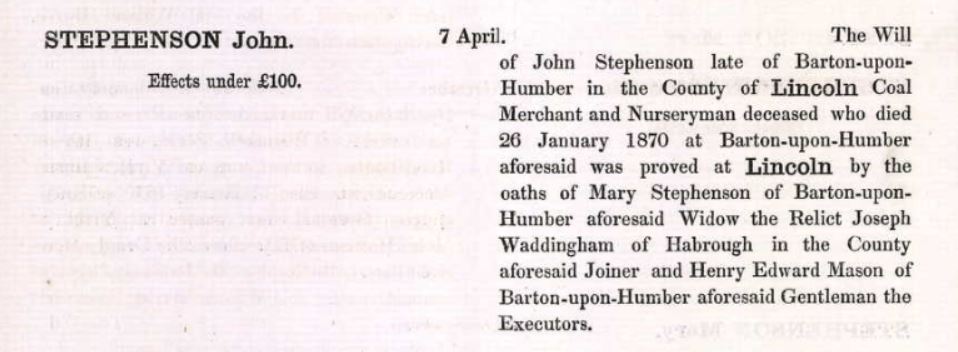
With John leaving Mary money or part of the business, she now became an ‘Independent’ woman. Perhaps she lived with her son George as mentioned in the 2 April 1871 census. Possibly she helped her daughter-in-law Elizabeth with the young children.
Mary survived John by 3 years, dying between April and June in 1873 aged 72 years. I could not find the parish registers for Barton so do not have any exact date for Mary’s death.
Children
Oldest child Charlotte married John Coupland, and their story can be found here.
George Gautby the second child, who was named for his older brother (1818-1819) married Elizabeth Hebblewhite in 1847 in Saxby. They had nine children and, as I believe, George took over the running of the nursery from his father. George died in 1883 at the age of 58 years. I’m not sure if the nursery continued in the Stephenson family. George’s oldest son Lawrence had, according to other people’s trees, immigrated to the United States. And from what I could find, the other sons were labourers in later census’.
Of the other children, it is mentioned in other people’s trees that Joseph and sister Mary Ann immigrated to the United States as well.
With no children or grandchildren to continue with the nursery, I believe it was probably sold or closed.
